INFINITI Q70 HYBRID 2014 Towing Guide
Manufacturer: INFINITI, Model Year: 2014, Model line: Q70 HYBRID, Model: INFINITI Q70 HYBRID 2014Pages: 25, PDF Size: 0.88 MB
Page 11 of 25
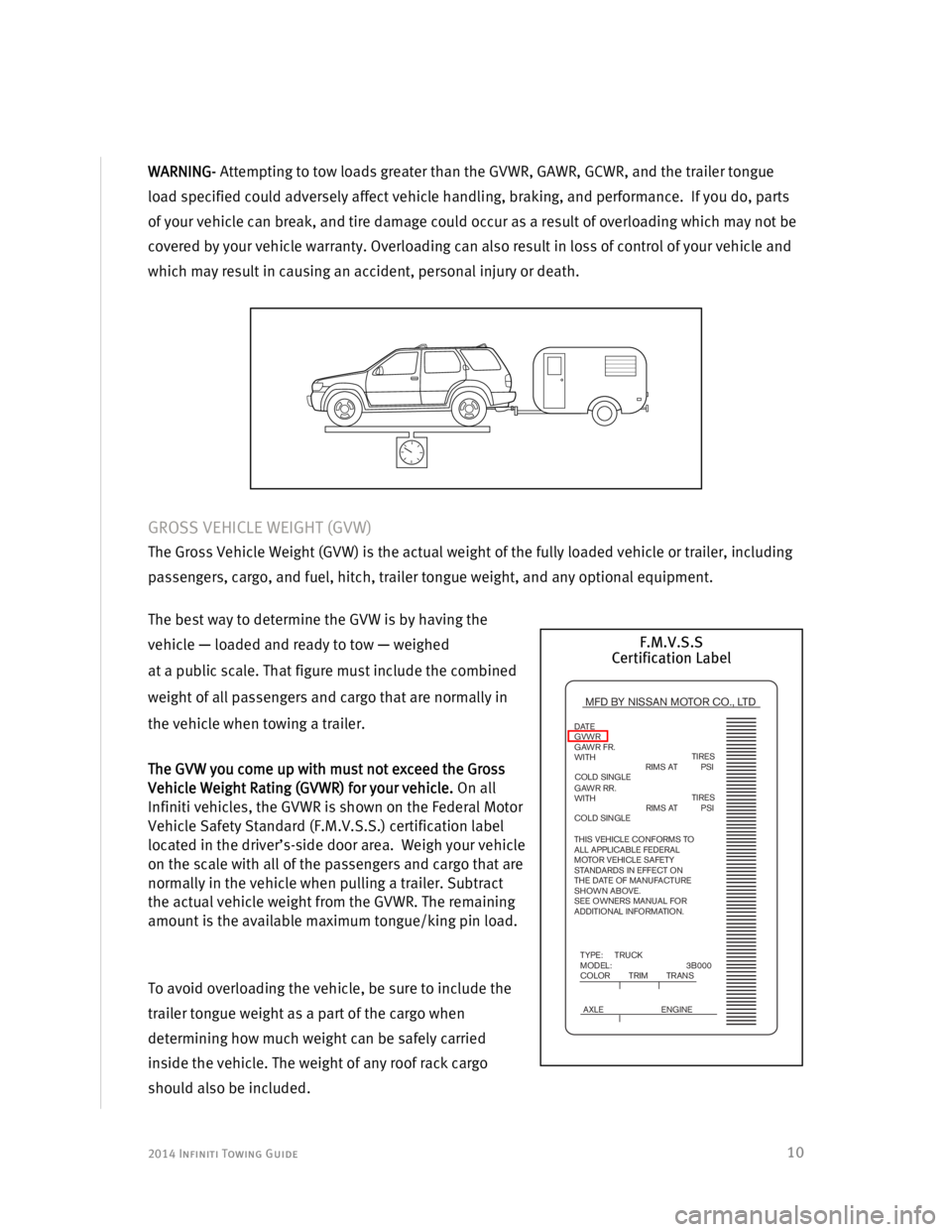
2014 Infiniti Towing Guide
10
WARNING- Attempting to tow loads greater than the GVWR, GAWR, GCWR, and the trailer tongue
load specified could adversely affect vehicle handling, braking, and performance. If you do, parts
of your vehicle can break, and tire damage could occur as a result of overloading which may not be
covered by your vehicle warranty. Overloading can also result in loss of control of your vehicle and
which may result in causing an accident, personal injury or death.
GROSS VEHICLE WEIGHT (GVW)
The Gross Vehicle Weight (GVW) is the actual weight of the fully loaded vehicle or trailer, including
passengers, cargo, and fuel, hitch, trailer tongue weight, and any optional equipment.
The best way to determine the GVW is by having the
vehicle — loaded and ready to tow — weighed
at a public scale. That figure must include the combined
weight of all passengers and cargo that are normally in
the vehicle when towing a trailer.
The GVW you come up with must not exceed the Gross
Vehicle Weight Rating (GVWR) for your vehicle. On all
Infiniti vehicles, the GVWR is shown on the Federal Motor
Vehicle Safety Standard (F.M.V.S.S.) certification label
located in the driver’s-side door area. Weigh your vehicle
on the scale with all of the passengers and cargo that are
normally in the vehicle when pulling a trailer. Subtract
the actual vehicle weight from the GVWR. The remaining
amount is the available maximum tongue/king pin load.
To avoid overloading the vehicle, be sure to include the
trailer tongue weight as a part of the cargo when
determining how much weight can be safely carried
inside the vehicle. The weight of any roof rack cargo
should also be included.
MFD BY NISSAN MOTOR CO., LTD
DATE
GVWR
GAWR FR.
WITH
GAWR RR.
WITH
THIS VEHICLE CONFORMS TO
ALL APPLICABLE FEDERAL
MOTOR VEHICLE SAFETY
STANDARDS IN EFFECT ON
THE DATE OF MANUFACTURE
SHOWN ABOVE.
SEE OWNERS MANUAL FOR
ADDITIONAL INFORMATION.
TIRES
TIRES
TYPE: TRUCK
MODEL: 3B000
COLOR TRIM TRANS
AXLE ENGINE
RIMS AT PSI
COLD SINGLERIMS AT PSI
COLD SINGLE
F.M.V.S.S
Certification Label
Page 12 of 25
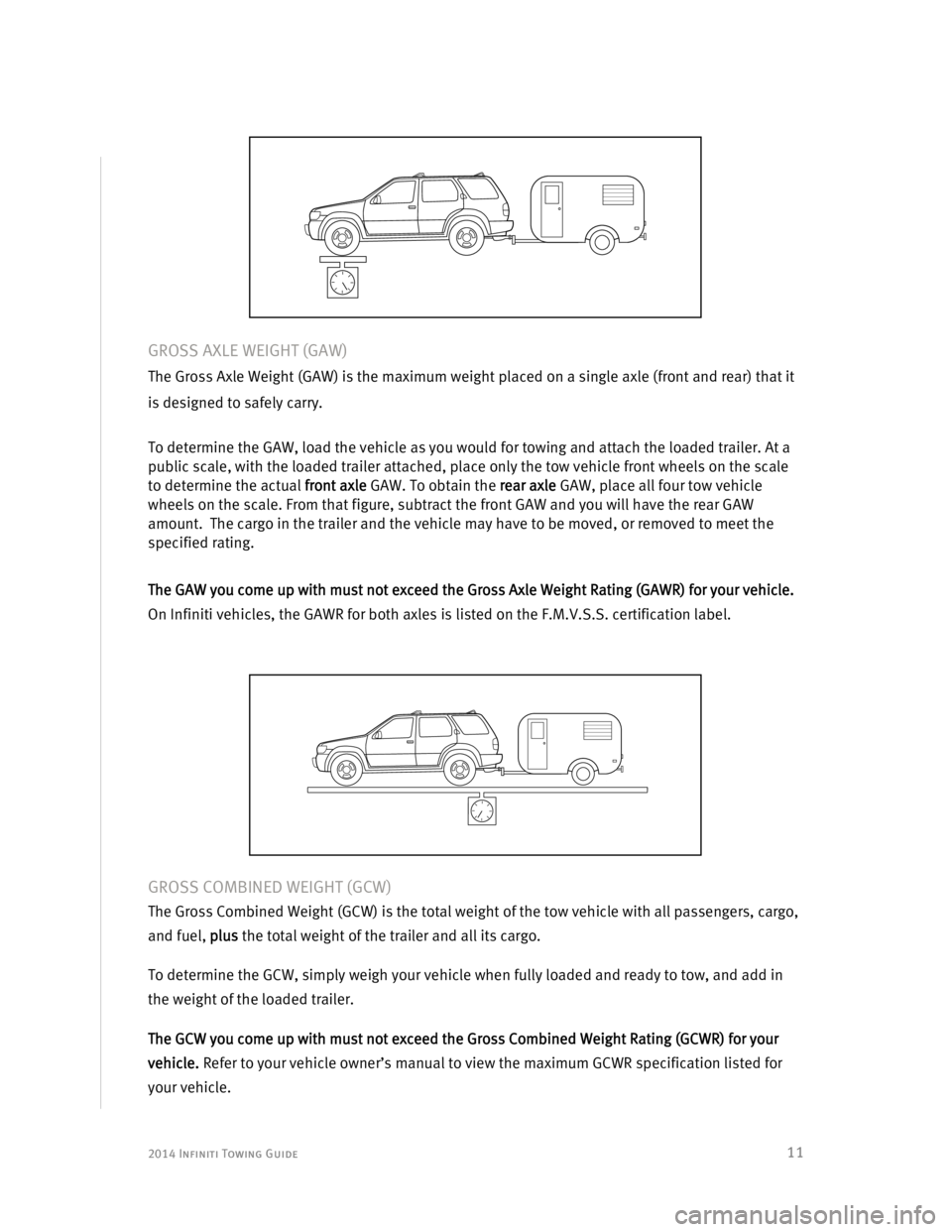
2014 Infiniti Towing Guide
11
GROSS AXLE WEIGHT (GAW)
The Gross Axle Weight (GAW) is the maximum weight placed on a single axle (front and rear) that it
is designed to safely carry.
To determine the GAW, load the vehicle as you would for towing and attach the loaded trailer. At a
public scale, with the loaded trailer attached, place only the tow vehicle front wheels on the scale
to determine the actual front axle GAW. To obtain the rear axle GAW, place all four tow vehicle
wheels on the scale. From that figure, subtract the front GAW and you will have the rear GAW
amount. The cargo in the trailer and the vehicle may have to be moved, or removed to meet the
specified rating.
The GAW you come up with must not exceed the Gross Axle Weight Rating (GAWR) for your vehicle.
On Infiniti vehicles, the GAWR for both axles is listed on the F.M.V.S.S. certification label.
GROSS COMBINED WEIGHT (GCW)
The Gross Combined Weight (GCW) is the total weight of the tow vehicle with all passengers, cargo,
and fuel, plus the total weight of the trailer and all its cargo.
To determine the GCW, simply weigh your vehicle when fully loaded and ready to tow, and add in
the weight of the loaded trailer.
The GCW you come up with must not exceed the Gross Combined Weight Rating (GCWR) for your
vehicle. Refer to your vehicle owner’s manual to view the maximum GCWR specification listed for
your vehicle.
Page 13 of 25
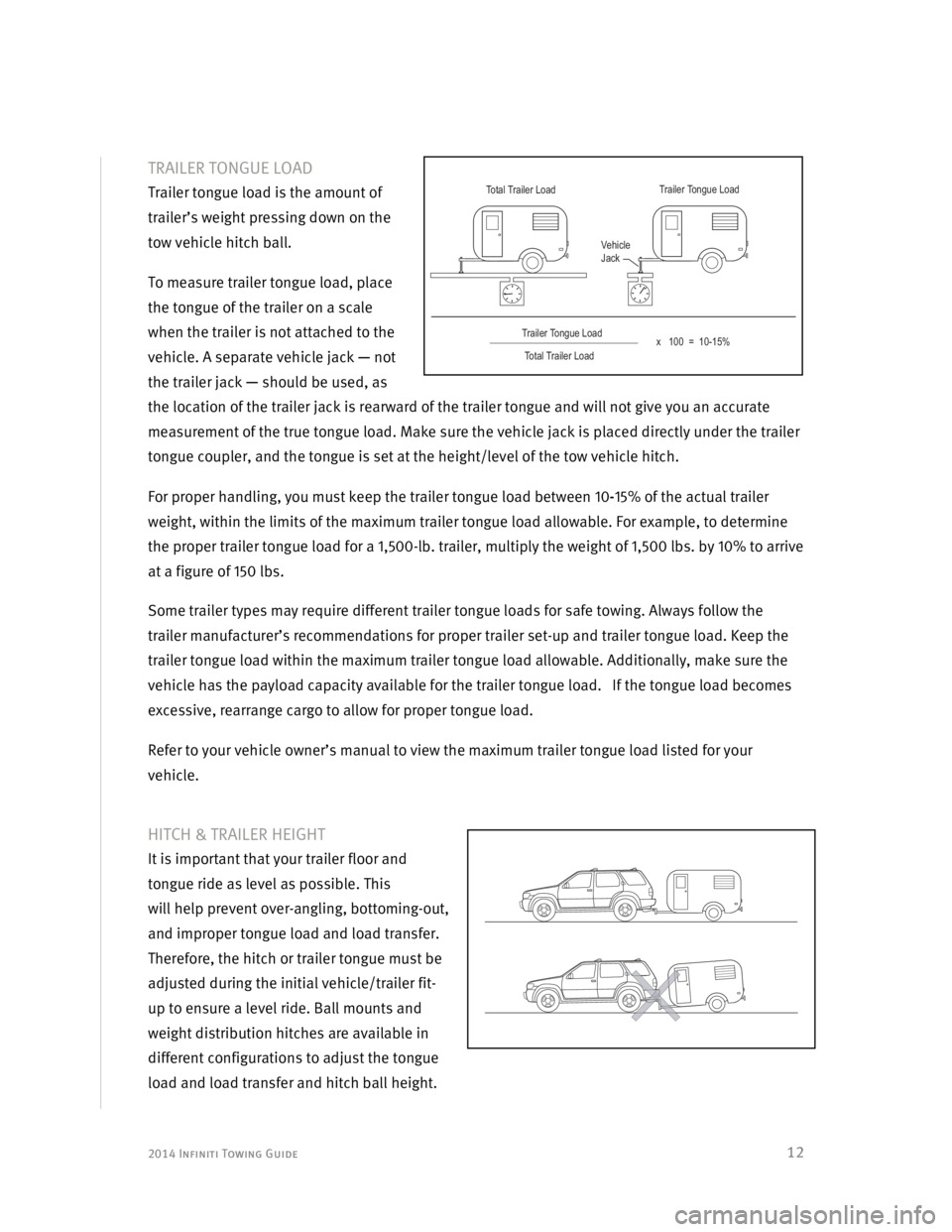
2014 Infiniti Towing Guide
12
TRAILER TONGUE LOAD
Trailer tongue load is the amount of
trailer’s weight pressing down on the
tow vehicle hitch ball.
To measure trailer tongue load, place
the tongue of the trailer on a scale
when the trailer is not attached to the
vehicle. A separate vehicle jack — not
the trailer jack — should be used, as
the location of the trailer jack is rearward of the trailer tongue and will not give you an accurate
measurement of the true tongue load. Make sure the vehicle jack is placed directly under the trailer
tongue coupler, and the tongue is set at the height/level of the tow vehicle hitch.
For proper handling, you must keep the trailer tongue load between 10-15% of the actual trailer
weight, within the limits of the maximum trailer tongue load allowable. For example, to determine
the proper trailer tongue load for a 1,500-lb. trailer, multiply the weight of 1,500 lbs. by 10% to arrive
at a figure of 150 lbs.
Some trailer types may require different trailer tongue loads for safe towing. Always follow the
trailer manufacturer’s recommendations for proper trailer set-up and trailer tongue load. Keep the
trailer tongue load within the maximum trailer tongue load allowable. Additionally, make sure the
vehicle has the payload capacity available for the trailer tongue load. If the tongue load becomes
excessive, rearrange cargo to allow for proper tongue load.
Refer to your vehicle owner’s manual to view the maximum trailer tongue load listed for your
vehicle.
HITCH & TRAILER HEIGHT
It is important that your trailer floor and
tongue ride as level as possible. This
will help prevent over-angling, bottoming-out,
and improper tongue load and load transfer.
Therefore, the hitch or trailer tongue must be
adjusted during the initial vehicle/trailer fit-
up to ensure a level ride. Ball mounts and
weight distribution hitches are available in
different configurations to adjust the tongue
load and load transfer and hitch ball height.
Trailer Tongue Load
Total Trailer Loadx 100 = 10-15%
Vehicle
Jack
Trailer Tongue Load
Total Trailer Load
Page 14 of 25
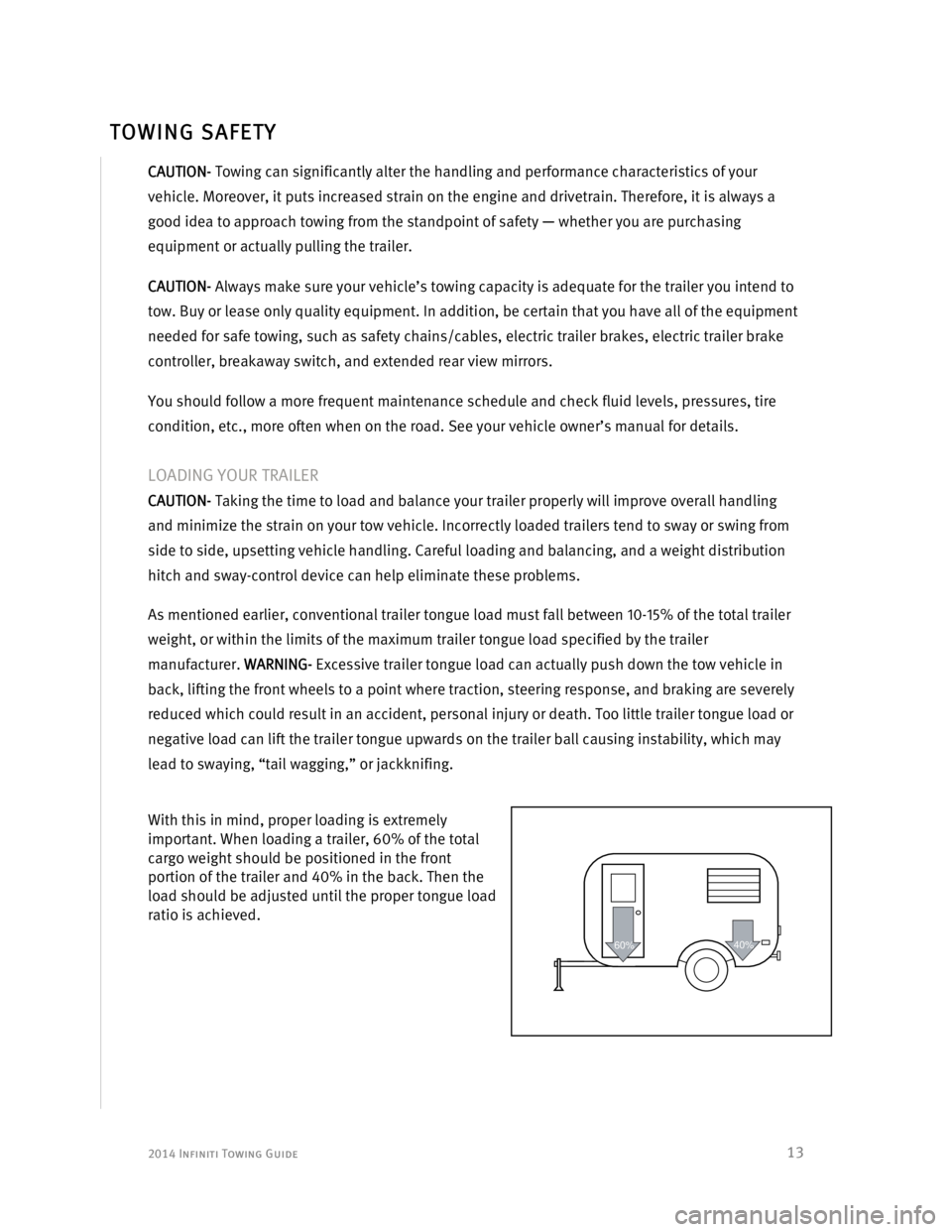
2014 Infiniti Towing Guide
13
CAUTION- Towing can significantly alter the handling and performance characteristics of your
vehicle. Moreover, it puts increased strain on the engine and drivetrain. Therefore, it is always a
good idea to approach towing from the standpoint of safety — whether you are purchasing
equipment or actually pulling the trailer.
CAUTION- Always make sure your vehicle’s towing capacity is adequate for the trailer you intend to
tow. Buy or lease only quality equipment. In addition, be certain that you have all of the equipment
needed for safe towing, such as safety chains/cables, electric trailer brakes, electric trailer brake
controller, breakaway switch, and extended rear view mirrors.
You should follow a more frequent maintenance schedule and check fluid levels, pressures, tire
condition, etc., more often when on the road. See your vehicle owner’s manual for details.
LOADING YOUR TRAILER
CAUTION- Taking the time to load and balance your trailer properly will improve overall handling
and minimize the strain on your tow vehicle. Incorrectly loaded trailers tend to sway or swing from
side to side, upsetting vehicle handling. Careful loading and balancing, and a weight distribution
hitch and sway-control device can help eliminate these problems.
As mentioned earlier, conventional trailer tongue load must fall between 10-15% of the total trailer
weight, or within the limits of the maximum trailer tongue load specified by the trailer
manufacturer. WARNING- Excessive trailer tongue load can actually push down the tow vehicle in
back, lifting the front wheels to a point where traction, steering response, and braking are severely
reduced which could result in an accident, personal injury or death. Too little trailer tongue load or
negative load can lift the trailer tongue upwards on the trailer ball causing instability, which may
lead to swaying, “tail wagging,” or jackknifing.
With this in mind, proper loading is extremely
important. When loading a trailer, 60% of the total
cargo weight should be positioned in the front
portion of the trailer and 40% in the back. Then the
load should be adjusted until the proper tongue load
ratio is achieved.
60%40%
TOWING SAFETY
Page 15 of 25
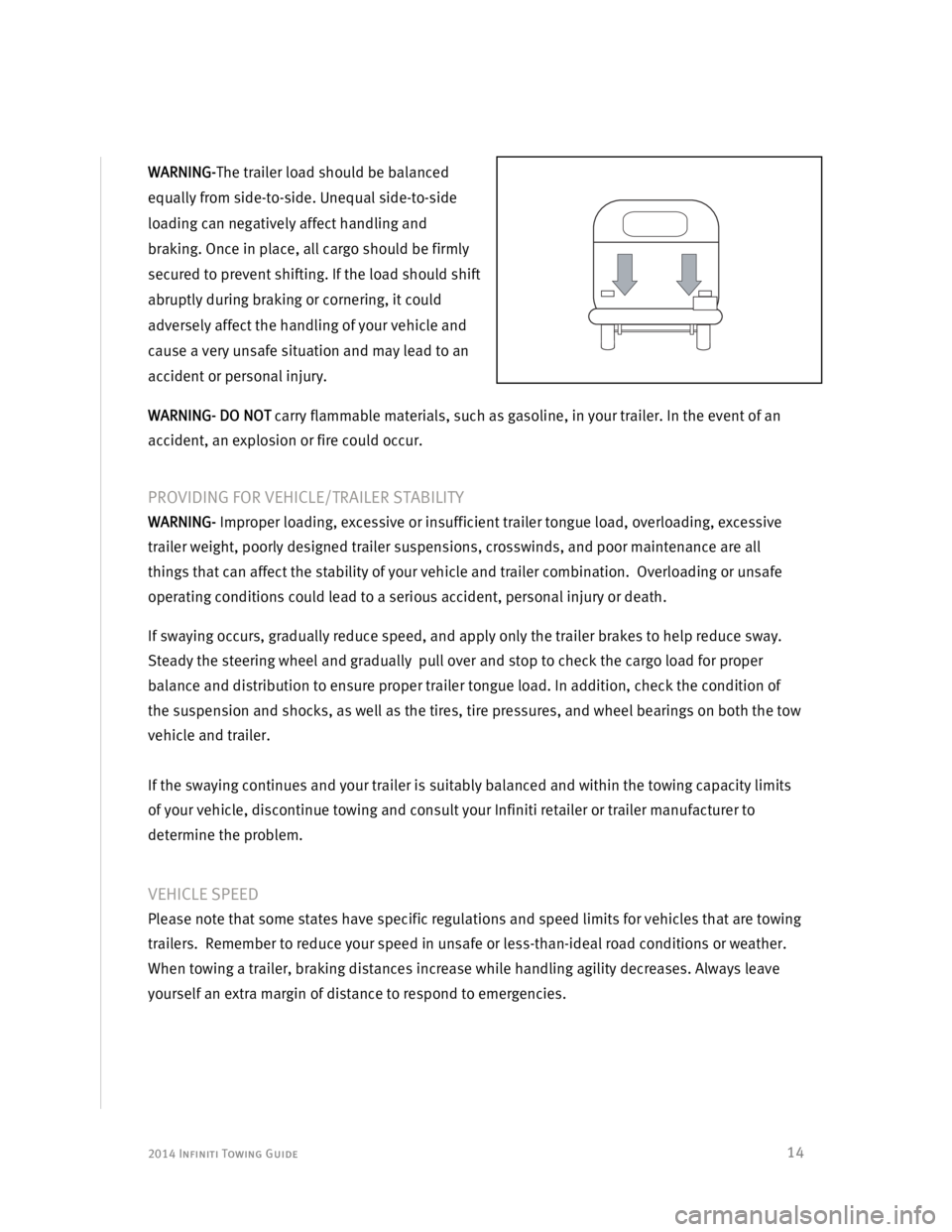
2014 Infiniti Towing Guide
14
WARNING-The trailer load should be balanced
equally from side-to-side. Unequal side-to-side
loading can negatively affect handling and
braking. Once in place, all cargo should be firmly
secured to prevent shifting. If the load should shift
abruptly during braking or cornering, it could
adversely affect the handling of your vehicle and
cause a very unsafe situation and may lead to an
accident or personal injury.
WARNING- DO NOT carry flammable materials, such as gasoline, in your trailer. In the event of an
accident, an explosion or fire could occur.
PROVIDING FOR VEHICLE/TRAILER STABILITY
WARNING- Improper loading, excessive or insufficient trailer tongue load, overloading, excessive
trailer weight, poorly designed trailer suspensions, crosswinds, and poor maintenance are all
things that can affect the stability of your vehicle and trailer combination. Overloading or unsafe
operating conditions could lead to a serious accident, personal injury or death.
If swaying occurs, gradually reduce speed, and apply only the trailer brakes to help reduce sway.
Steady the steering wheel and gradually pull over and stop to check the cargo load for proper
balance and distribution to ensure proper trailer tongue load. In addition, check the condition of
the suspension and shocks, as well as the tires, tire pressures, and wheel bearings on both the tow
vehicle and trailer.
If the swaying continues and your trailer is suitably balanced and within the towing capacity limits
of your vehicle, discontinue towing and consult your Infiniti retailer or trailer manufacturer to
determine the problem.
VEHICLE SPEED
Please note that some states have specific regulations and speed limits for vehicles that are towing
trailers. Remember to reduce your speed in unsafe or less-than-ideal road conditions or weather.
When towing a trailer, braking distances increase while handling agility decreases. Always leave
yourself an extra margin of distance to respond to emergencies.
Page 16 of 25
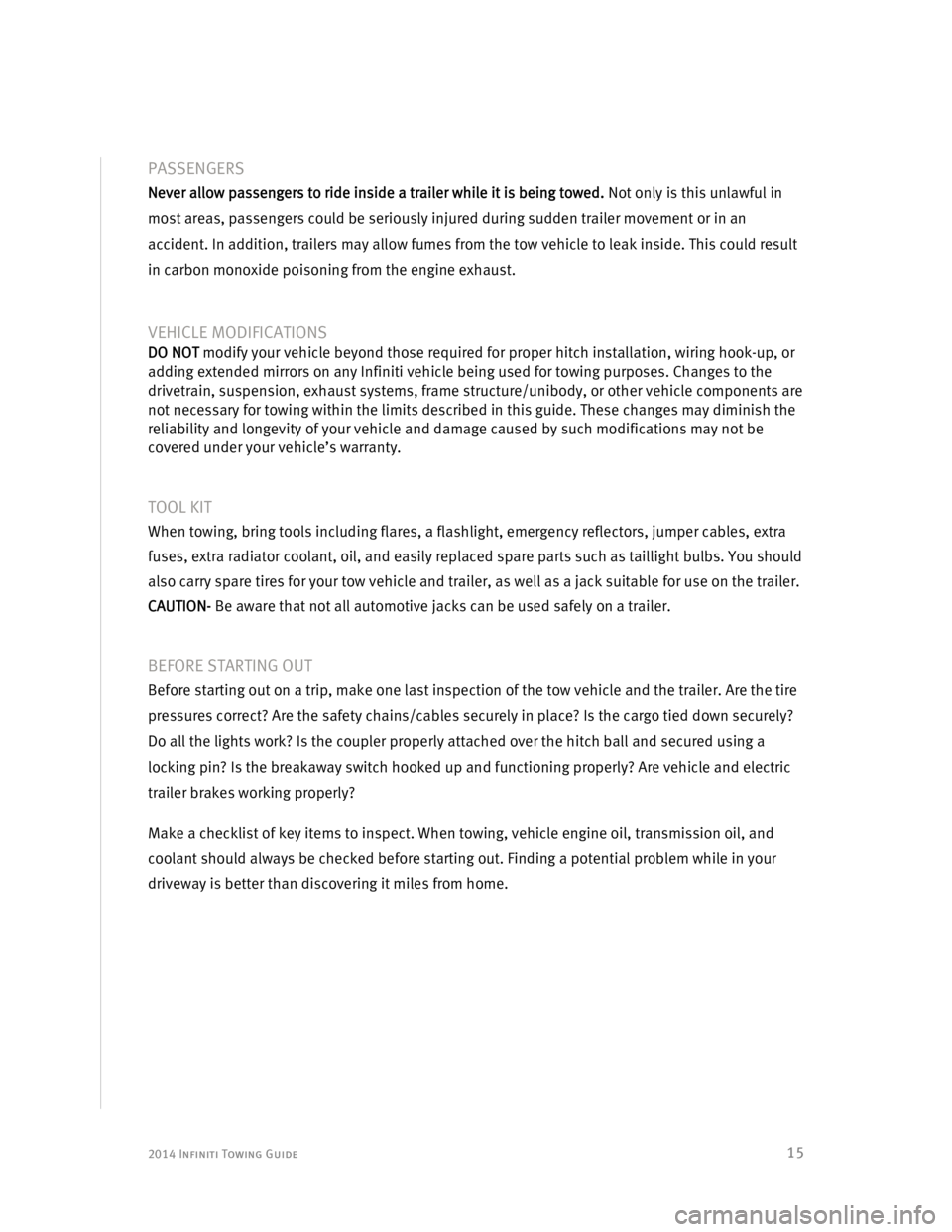
2014 Infiniti Towing Guide
15
PASSENGERS
Never allow passengers to ride inside a trailer while it is being towed. Not only is this unlawful in
most areas, passengers could be seriously injured during sudden trailer movement or in an
accident. In addition, trailers may allow fumes from the tow vehicle to leak inside. This could result
in carbon monoxide poisoning from the engine exhaust.
VEHICLE MODIFICATIONS
DO NOT modify your vehicle beyond those required for proper hitch installation, wiring hook-up, or
adding extended mirrors on any Infiniti vehicle being used for towing purposes. Changes to the
drivetrain, suspension, exhaust systems, frame structure/unibody, or other vehicle components are
not necessary for towing within the limits described in this guide. These changes may diminish the
reliability and longevity of your vehicle and damage caused by such modifications may not be
covered under your vehicle’s warranty.
TOOL KIT
When towing, bring tools including flares, a flashlight, emergency reflectors, jumper cables, extra
fuses, extra radiator coolant, oil, and easily replaced spare parts such as taillight bulbs. You should
also carry spare tires for your tow vehicle and trailer, as well as a jack suitable for use on the trailer.
CAUTION- Be aware that not all automotive jacks can be used safely on a trailer.
BEFORE STARTING OUT
Before starting out on a trip, make one last inspection of the tow vehicle and the trailer. Are the tire
pressures correct? Are the safety chains/cables securely in place? Is the cargo tied down securely?
Do all the lights work? Is the coupler properly attached over the hitch ball and secured using a
locking pin? Is the breakaway switch hooked up and functioning properly? Are vehicle and electric
trailer brakes working properly?
Make a checklist of key items to inspect. When towing, vehicle engine oil, transmission oil, and
coolant should always be checked before starting out. Finding a potential problem while in your
driveway is better than discovering it miles from home.
Page 17 of 25
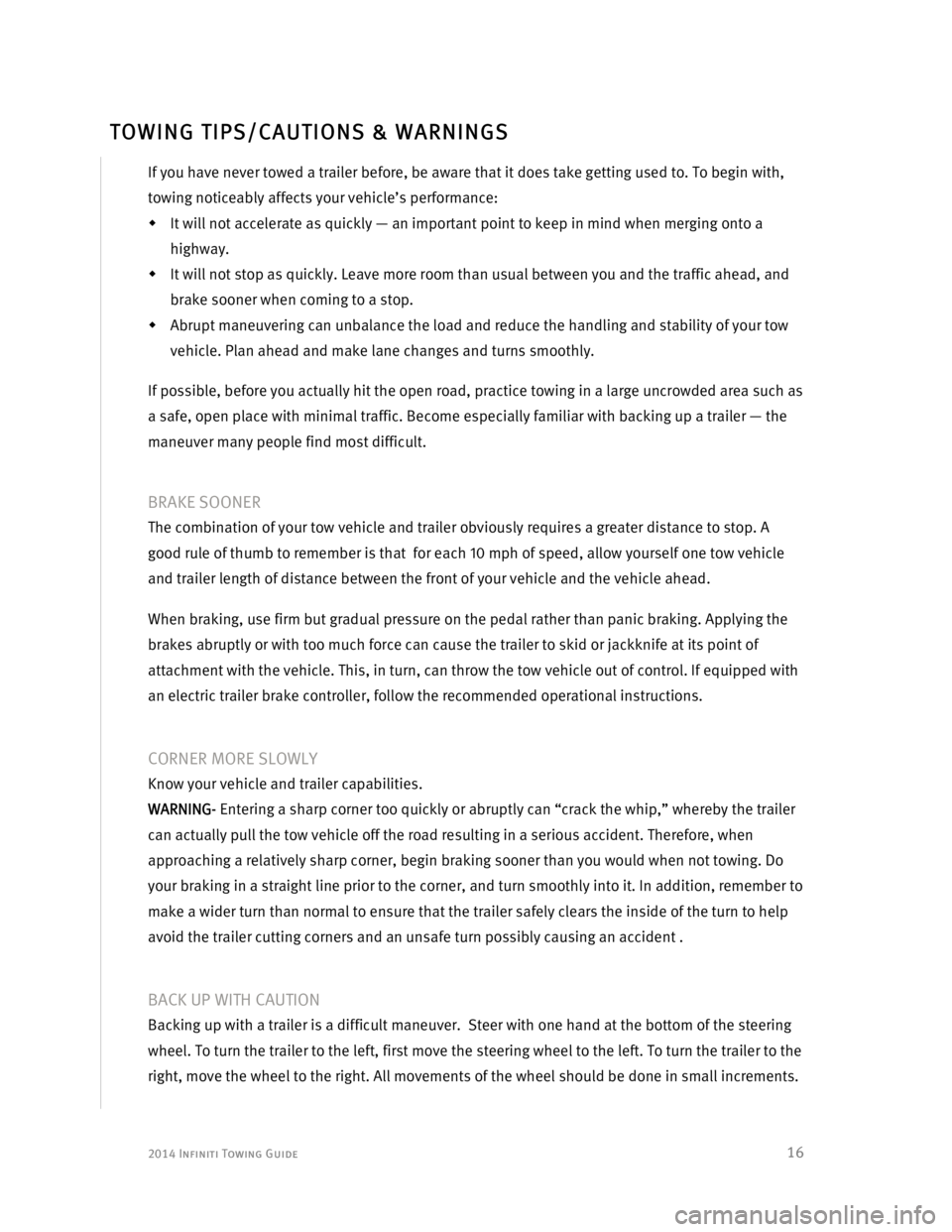
2014 Infiniti Towing Guide
16
If you have never towed a trailer before, be aware that it does take getting used to. To begin with,
towing noticeably affects your vehicle’s performance:
�Š It will not accelerate as quickly — an important point to keep in mind when merging onto a
highway.
�Š It will not stop as quickly. Leave more room than usual between you and the traffic ahead, and
brake sooner when coming to a stop.
�Š Abrupt maneuvering can unbalance the load and reduce the handling and stability of your tow
vehicle. Plan ahead and make lane changes and turns smoothly.
If possible, before you actually hit the open road, practice towing in a large uncrowded area such as
a safe, open place with minimal traffic. Become especially familiar with backing up a trailer — the
maneuver many people find most difficult.
BRAKE SOONER
The combination of your tow vehicle and trailer obviously requires a greater distance to stop. A
good rule of thumb to remember is that for each 10 mph of speed, allow yourself one tow vehicle
and trailer length of distance between the front of your vehicle and the vehicle ahead.
When braking, use firm but gradual pressure on the pedal rather than panic braking. Applying the
brakes abruptly or with too much force can cause the trailer to skid or jackknife at its point of
attachment with the vehicle. This, in turn, can throw the tow vehicle out of control. If equipped with
an electric trailer brake controller, follow the recommended operational instructions.
CORNER MORE SLOWLY
Know your vehicle and trailer capabilities.
WARNING- Entering a sharp corner too quickly or abruptly can “crack the whip,” whereby the trailer
can actually pull the tow vehicle off the road resulting in a serious accident. Therefore, when
approaching a relatively sharp corner, begin braking sooner than you would when not towing. Do
your braking in a straight line prior to the corner, and turn smoothly into it. In addition, remember to
make a wider turn than normal to ensure that the trailer safely clears the inside of the turn to help
avoid the trailer cutting corners and an unsafe turn possibly causing an accident .
BACK UP WITH CAUTION
Backing up with a trailer is a difficult maneuver. Steer with one hand at the bottom of the steering
wheel. To turn the trailer to the left, first move the steering wheel to the left. To turn the trailer to the
right, move the wheel to the right. All movements of the wheel should be done in small increments.
TOWING TIPS/CAUTIONS & WARNINGS
Page 18 of 25
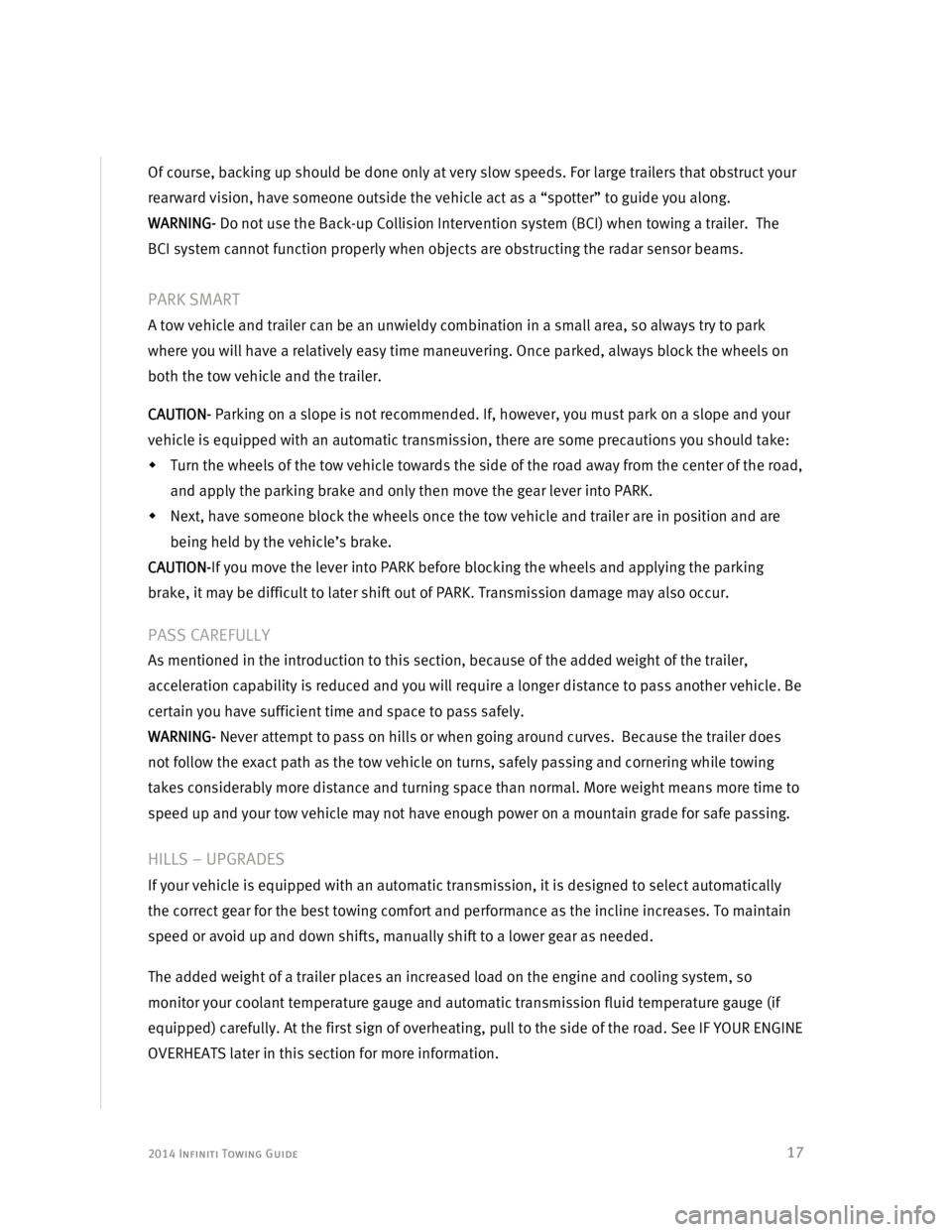
2014 Infiniti Towing Guide
17
Of course, backing up should be done only at very slow speeds. For large trailers that obstruct your
rearward vision, have someone outside the vehicle act as a “spotter” to guide you along.
WARNING- Do not use the Back-up Collision Intervention system (BCI) when towing a trailer. The
BCI system cannot function properly when objects are obstructing the radar sensor beams.
PARK SMART
A tow vehicle and trailer can be an unwieldy combination in a small area, so always try to park
where you will have a relatively easy time maneuvering. Once parked, always block the wheels on
both the tow vehicle and the trailer.
CAUTION- Parking on a slope is not recommended. If, however, you must park on a slope and your
vehicle is equipped with an automatic transmission, there are some precautions you should take:
�Š Turn the wheels of the tow vehicle towards the side of the road away from the center of the road,
and apply the parking brake and only then move the gear lever into PARK.
�Š Next, have someone block the wheels once the tow vehicle and trailer are in position and are
being held by the vehicle’s brake.
CAUTION-If you move the lever into PARK before blocking the wheels and applying the parking
brake, it may be difficult to later shift out of PARK. Transmission damage may also occur.
PASS CAREFULLY
As mentioned in the introduction to this section, because of the added weight of the trailer,
acceleration capability is reduced and you will require a longer distance to pass another vehicle. Be
certain you have sufficient time and space to pass safely.
WARNING- Never attempt to pass on hills or when going around curves. Because the trailer does
not follow the exact path as the tow vehicle on turns, safely passing and cornering while towing
takes considerably more distance and turning space than normal. More weight means more time to
speed up and your tow vehicle may not have enough power on a mountain grade for safe passing.
HILLS – UPGRADES
If your vehicle is equipped with an automatic transmission, it is designed to select automatically
the correct gear for the best towing comfort and performance as the incline increases. To maintain
speed or avoid up and down shifts, manually shift to a lower gear as needed.
The added weight of a trailer places an increased load on the engine and cooling system, so
monitor your coolant temperature gauge and automatic transmission fluid temperature gauge (if
equipped) carefully. At the first sign of overheating, pull to the side of the road. See IF YOUR ENGINE
OVERHEATS later in this section for more information.
Page 19 of 25
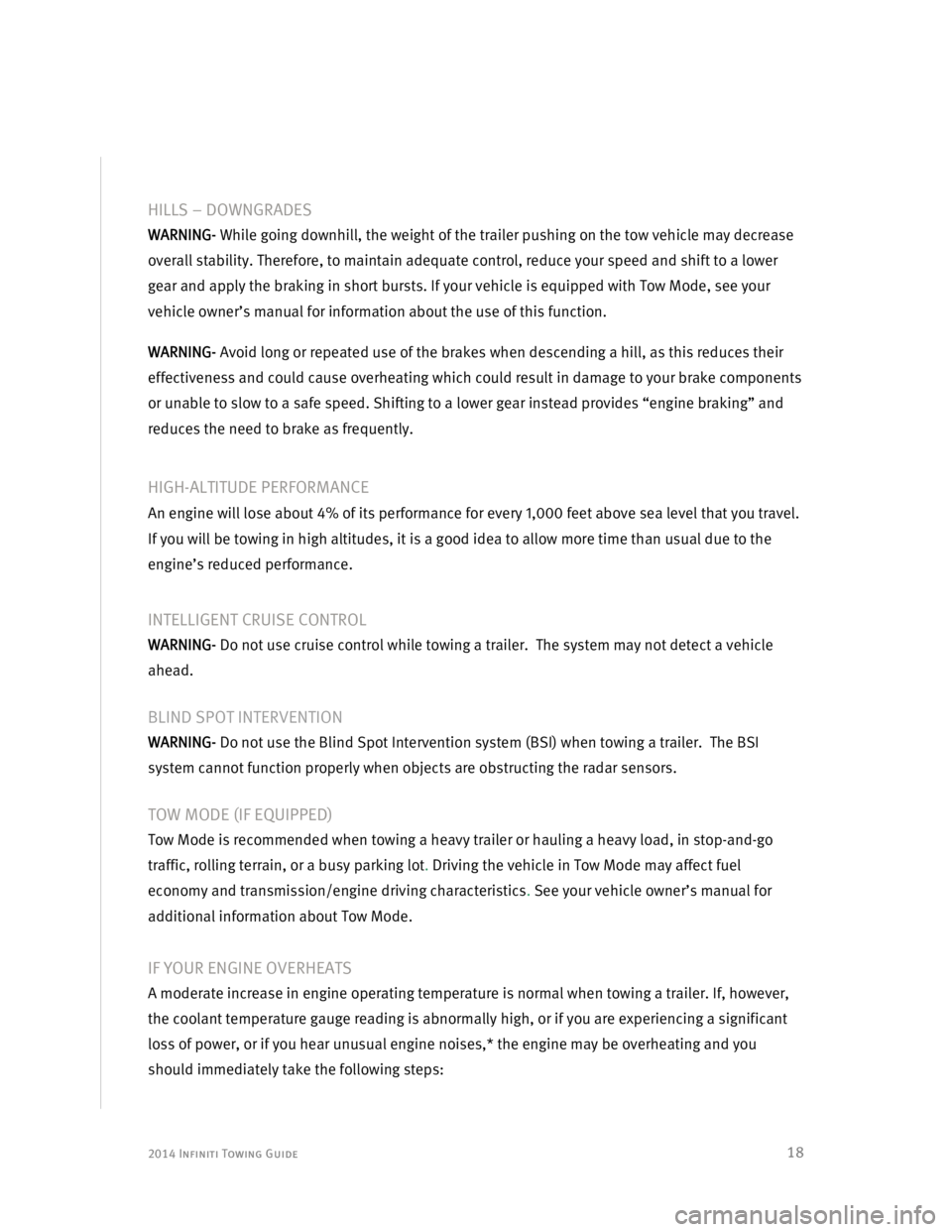
2014 Infiniti Towing Guide
18
HILLS – DOWNGRADES
WARNING- While going downhill, the weight of the trailer pushing on the tow vehicle may decrease
overall stability. Therefore, to maintain adequate control, reduce your speed and shift to a lower
gear and apply the braking in short bursts. If your vehicle is equipped with Tow Mode, see your
vehicle owner’s manual for information about the use of this function.
WARNING- Avoid long or repeated use of the brakes when descending a hill, as this reduces their
effectiveness and could cause overheating which could result in damage to your brake components
or unable to slow to a safe speed. Shifting to a lower gear instead provides “engine braking” and
reduces the need to brake as frequently.
HIGH-ALTITUDE PERFORMANCE
An engine will lose about 4% of its performance for every 1,000 feet above sea level that you travel.
If you will be towing in high altitudes, it is a good idea to allow more time than usual due to the
engine’s reduced performance.
INTELLIGENT CRUISE CONTROL
WARNING- Do not use cruise control while towing a trailer. The system may not detect a vehicle
ahead.
BLIND SPOT INTERVENTION
WARNING- Do not use the Blind Spot Intervention system (BSI) when towing a trailer. The BSI
system cannot function properly when objects are obstructing the radar sensors.
TOW MODE (IF EQUIPPED)
Tow Mode is recommended when towing a heavy trailer or hauling a heavy load, in stop-and-go
traffic, rolling terrain, or a busy parking lot. Driving the vehicle in Tow Mode may affect fuel
economy and transmission/engine driving characteristics. See your vehicle owner’s manual for
additional information about Tow Mode.
IF YOUR ENGINE OVERHEATS
A moderate increase in engine operating temperature is normal when towing a trailer. If, however,
the coolant temperature gauge reading is abnormally high, or if you are experiencing a significant
loss of power, or if you hear unusual engine noises,* the engine may be overheating and you
should immediately take the following steps:
Page 20 of 25
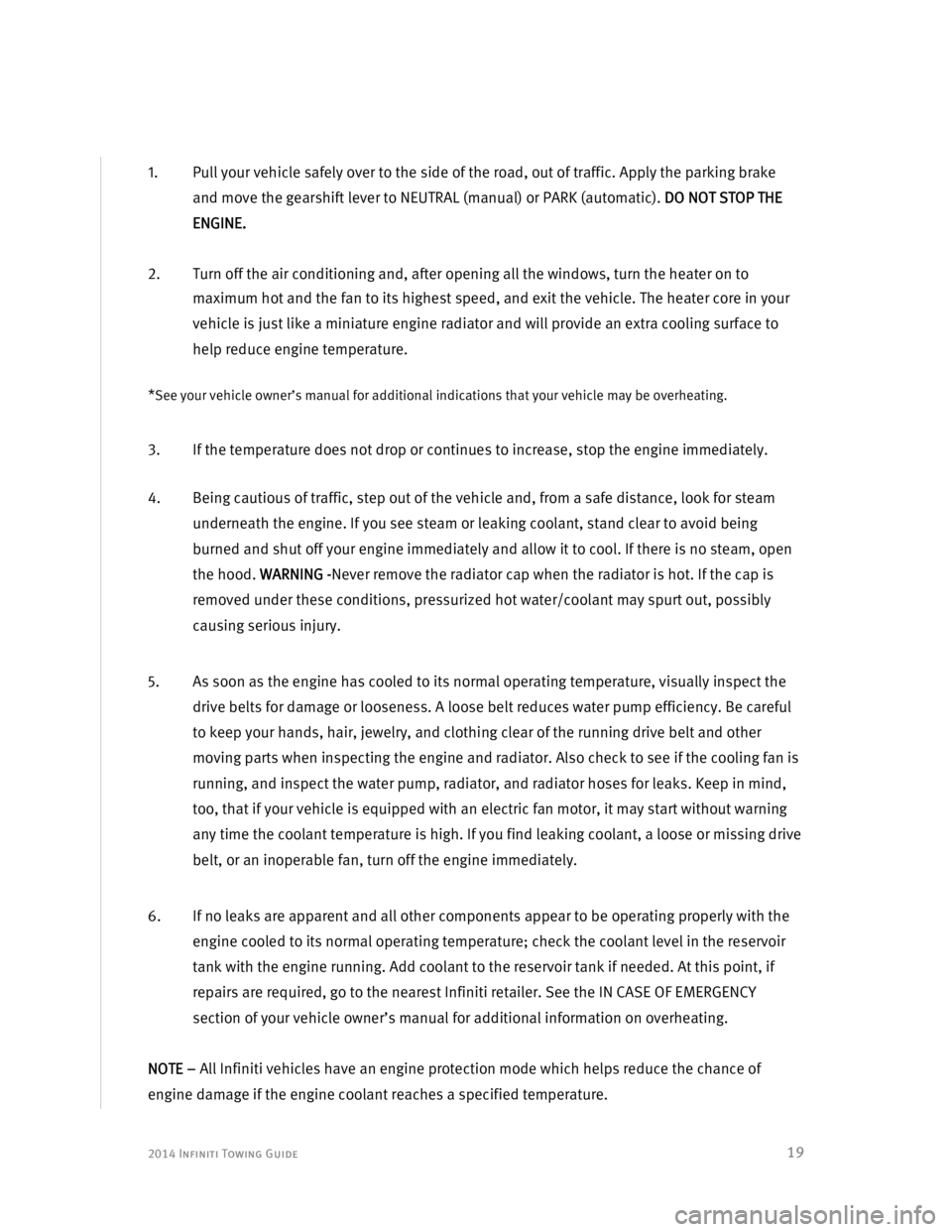
2014 Infiniti Towing Guide
19
1. Pull your vehicle safely over to the side of the road, out of traffic. Apply the parking brake
and move the gearshift lever to NEUTRAL (manual) or PARK (automatic). DO NOT STOP THE
ENGINE.
2. Turn off the air conditioning and, after opening all the windows, turn the heater on to
maximum hot and the fan to its highest speed, and exit the vehicle. The heater core in your
vehicle is just like a miniature engine radiator and will provide an extra cooling surface to
help reduce engine temperature.
*
See your vehicle owner’s manual for additional indications that your vehicle may be overheating.
3. If the temperature does not drop or continues to increase, stop the engine immediately.
4. Being cautious of traffic, step out of the vehicle and, from a safe distance, look for steam
underneath the engine. If you see steam or leaking coolant, stand clear to avoid being
burned and shut off your engine immediately and allow it to cool. If there is no steam, open
the hood. WARNING -Never remove the radiator cap when the radiator is hot. If the cap is
removed under these conditions, pressurized hot water/coolant may spurt out, possibly
causing serious injury.
5. As soon as the engine has cooled to its normal operating temperature, visually inspect the
drive belts for damage or looseness. A loose belt reduces water pump efficiency. Be careful
to keep your hands, hair, jewelry, and clothing clear of the running drive belt and other
moving parts when inspecting the engine and radiator. Also check to see if the cooling fan is
running, and inspect the water pump, radiator, and radiator hoses for leaks. Keep in mind,
too, that if your vehicle is equipped with an electric fan motor, it may start without warning
any time the coolant temperature is high. If you find leaking coolant, a loose or missing drive
belt, or an inoperable fan, turn off the engine immediately.
6. If no leaks are apparent and all other components appear to be operating properly with the
engine cooled to its normal operating temperature; check the coolant level in the reservoir
tank with the engine running. Add coolant to the reservoir tank if needed. At this point, if
repairs are required, go to the nearest Infiniti retailer. See the IN CASE OF EMERGENCY
section of your vehicle owner’s manual for additional information on overheating.
NOTE – All Infiniti vehicles have an engine protection mode which helps reduce the chance of
engine damage if the engine coolant reaches a specified temperature.